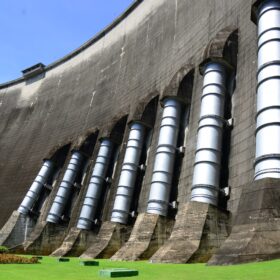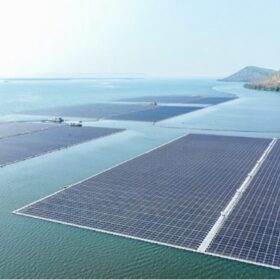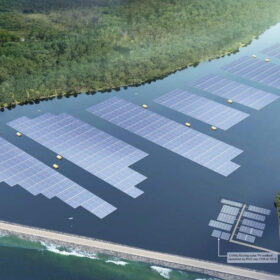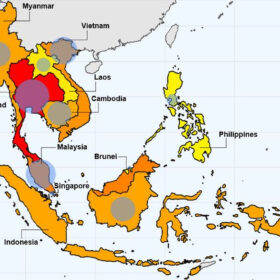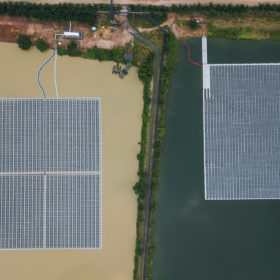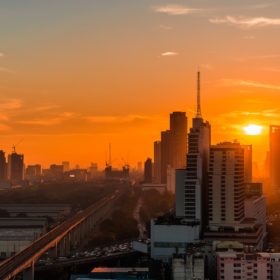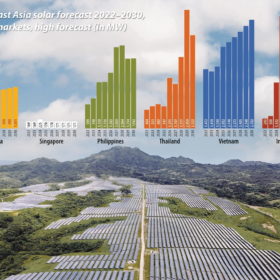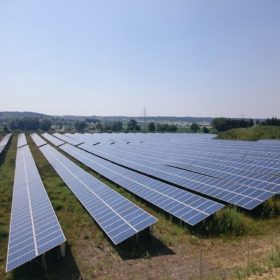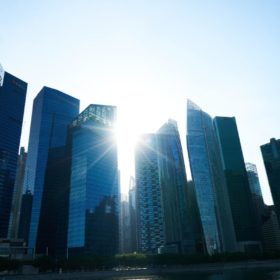Southeast Asia bets big on pumped hydro with 18 GW tipped by 2033
The increasing role of pumped hydro technology in Australia’s renewable energy transition is expected to be mirrored in the neighbouring Southeast Asia region with international consultancy Rystad Energy tipping the total capacity of operational projects will surge from the current 2.3 GW to 18 GW by 2033.
Hydro-solar hybrid starts commercial operations in Thailand
The Generating Authority of Thailand has announced that a 24 MW floating hydro-solar hybrid project has commenced commercial operations in the country’s northeast. The installation is part of wider plans to develop 16 floating solar projects with a combined capacity of 2,725 MW.
Weekend read: the ‘next big thing’
The PV industry in Southeast Asia has come a long way since guest author Ragna Schmidt-Haupt, partner at Everoze, reported on solar financing innovation in the region more than a decade ago. In this article, she outlines five factors for success, the newest of which has the potential to become a game changer, and not only in Southeast Asia.
Southeast Asia has technical potential to deploy over 1 TW of floating PV
A group of researchers from the US National Renewable Energy Laboratory assessed the potential for floating PV (FPV) plants at reservoirs and natural waterbodies in 10 Southeast Asian countries. It found that the overall FPV technical potential for the region ranges from 477 GW to 1,046 GW.
Southeast Asia solar markets set for growth this year
New PV capacity additions in Southeast Asia are expected to bounce back this year for the first time since 2020, according to the Asian Photovoltaic Industry Association. The market is expected to grow by 13% in 2023, for 3.8 GW of new installations.
BayWa’s lessons from expanding into Southeast Asia
In recent years, global renewables developer BayWa re has been turning its attention to the Asia Pacific, expanding into Southeast Asia. Junrhey Castro, the company’s director of solar distribution in Southeast Asia, sat down with pv magazine Australia to discuss its experiences in the emerging markets of the Philippines, Thailand, Malaysia, and Vietnam.
Thailand introduces FIT scheme for solar, storage
In an unexpected move, the government of Thailand has introduced a feed-in-tariff (FIT) of $0.090 (THB 2.1679)/kWh over 25 years for solar and a 25-year FIT of THB $0.075 (THB 2.8331)/kWh for solar plus storage.
Weekend read: Southeast Asian interconnection
While near neighbours, the electricity generation of the countries of Southeast Asia couldn’t be further apart. Indonesia burns locally mined coal, Malaysia has reserves of oil and gas, while populous Singapore, Vietnam, and the Philippines, depend on fossil fuel imports. They could all benefit from increased solar imports, but higher grid capacities and interconnection are key for an opportunity to unlock the power of the sun.
IRENA highlights solar critical to ASEAN energy transition
Indonesia will have to get to work installing more than 24 GW of solar this year – and every year – if the region is to achieve the 2.1 TW to 2.4 TW of photovoltaics the International Renewable Energy Agency has estimated it will require to achieve a net zero carbon energy system by 2050.
Singapore regulator issues fresh appeal for clean power
Singapore’s Energy Market Authority has already attracted proposals for 1.2 GW of renewable electricity, to be generated in four southeast Asian nations, and wants to raise that figure to 4 GW by 2035.
